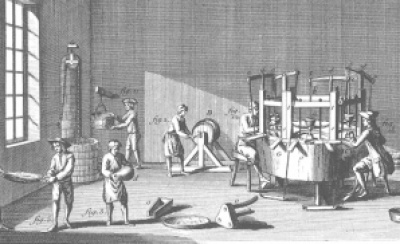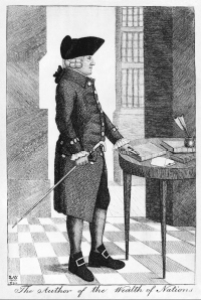This post continues my look at Simon Schaffer, “Enlightened Automata” in The Sciences in Enlightened Europe, edited by William Clark, Jan Golinski, and Schaffer (Chicago University Press, 1999).
 The division of labor in pin manufacturing. From the Encyclopédie.
The division of labor in pin manufacturing. From the Encyclopédie.
Pt. 4 examined Schaffer’s characterization of an ideology associated with the Enlightenment, reflected in the era’s fascination with automata. This ideology revolved around the belief that physiology, labor, cognition, and social relations could be comprehended in mechanical terms, and governed according to philosophically derived managerial regimens. Pt. 4 also explored Schaffer’s situation of his arguments within a large, diverse, and venerable historiography of the mechanistic aspirations of the Enlightenment.
Pt. 5 turns to look at the historical events that Schaffer marshaled into his history of this ideology.
In charting the rise of mechanistic reasoning, many authors have been prone to identifying it with a concomitant decline in spiritualist dogma, or (for critics) ethical consciousness. As we have seen, Derek Price (1922-1983) believed that in “the augmenting success of automata through the age of Descartes … we see the prime tangible manifestation of the triumph of rational, mechanistic explanation over those of the vitalists and theologians.” Similarly, critics such as Max Horkheimer (1895-1973) and Theodor Adorno (1903-1969), the authors of Dialectic of Enlightenment (1947), regarded the ascendancy of instrumental reason as a source of modern evil.
Throughout his oeuvre, Schaffer has been been among those historians who have been sensitive to the fact that, traditionally, historians’ interpretations of historical philosophical positions have often owed more to their taking historical polemics at face value, than to any careful reading of the actual philosophy. Thus, historians who have identified 17th-century mechanistic philosophies with anti-theological sentiment tend to ignore or dismiss mechanistic philosophers’ theological arguments—and, indeed, their non-mechanistic interests in general—and in doing so they implicitly accept the charges of 17th- and 18th-century theologians who were eager to defend more traditional doctrines of the soul, free will, and culpability for sin.
Contra Price, Schaffer points out that, among natural philosophers, it was vitalist doctrines that were widely considered to be radically materialistic. Notably, Rev. Samuel Clarke (1675-1729) argued that vitalism’s model of a completely self-regulating cosmos reserved no place for the external intervention of souls and God, whereas the inert matter of the Newtonian cosmos required it. Of course, Clarke’s major philosophical opponent, vis viva proponent Gottfried Leibniz (1646-1716), likewise had very well-developed ideas on the autonomy of the soul, the agency of God, predestination, and the nature of evil, which he wrote about in works of no less stature than his Theodicy (1710) and Monadology (1714).
 La Mettrie
La Mettrie
But, for Schaffer, the details of individual philosophers’ metaphysics, and the specific questions they disputed, are immaterial to his interest in the general mechanization of the philosophy of the age. By this he seems to mean the generic effort of that era’s philosophy to reduce the phenomena of nature, body, mind, and society to the interplay of basic principles, and its adventurous propensity to interweave natural, physiological, cognitive, and social explanatory schemes.
However, this mechanization of philosophy did not entail the reduction of the social to the physical, nor did it necessarily suppose the future to be deterministically predictable. As Schaffer points out, even so radical a mechanist as Julien Offray de La Mettrie (1709-1751), author of L’homme Machine (1748), was not so committed to a mechanistic metaphysics as one might suppose: his “man machine was not an iatromechanical reverie of clockwork and pulleys, but a natural body subject to exercise and training, imbued with innate vitality and therefore simultaneously capable of, and requiring, external discipline.” What was significant about La Mettrie was not his “sketchy summary of the active matter whose organization formed the human body,” but the way this vision supposedly “dispossessed priests of their authority,” and the way La Mettrie used “medical principles to construct an entire social therapeutics” (142).
I believe that Schaffer is correct in characterizing the philosophy of the 18th century as generically mechanical. At the same time, this characterization is so broad that it elides important differences in the content of philosophers’ ideas, while collectively identifying their thought as intrinsically aligned with the production of a social order of enlightened managerialism. It is by this route that he arrives at the same conclusion as prior critics of the Enlightenment.
Schaffer constructs his identification by ascribing a strong ideological significance to certain aspects of philosophers’ ideas and work.
First, and most convincingly, he notes their insistence on the opposition of philosophical reasoning to vulgar superstition and reckless or mendacious scheming. Thus (132):
[Scottish philosophic historian Adam] Ferguson [1723-1816] attributed the ‘ignorance and mystery’ of irrational superstition to subjects’ perplexity when faced with ‘strange and uncommon situations.’ Truly enlightened social order hinged on ‘the study of nature by which we are led to substitute a wise providence operating by physical causes in the place of phantoms that terrify or amuse the ignorant.’ [Adam] Smith [1723-1790] argued similarly that ‘the lowest and most pusillanimous superstition’ was spawned by ‘every object of nature … whose operations are not perfectly regular,’ and that were therefore ‘supposed to act by the direction of some invisible and designing power.’ Struck by David Hume’s [1711-1776] critique of innate causal powers, Scottish philosophers claimed that the progress of machine philosophy calmed these fears and wonders by imaginatively connecting phenomena under lawlike regularities.
Second, Schaffer notes mechanistic philosophers’ occupation of positions of management and governance. I have previously noted the significance he ascribed to Charles Dufay’s (1698-1739) management of the Gobelins dye works. La Mettrie wrote L’homme Machine while he “was in charge of the French military hospitals in the theater of war in the Low Countries” (142). The French government hired the engineer and celebrated automaton designer Jacques Vaucanson (1709-1782) “as inspector of the silk trade, sending him in 1741 to Lyons and to Piedmont to examine best practices in the silk mills” (144).
“After managing military works in the French West Indies in the 1760s, the eminent engineer and academician Charles Coulomb [1736-1806] tried to evaluate the maximum effect extractable from labor.” Coulomb’s “close colleague,” Antoine Laurent-Lavoisier (1743-1794), “was involved in studies of the balance of profit and loss in the national agrarian economy and of means to reform the French political machine. At just the same time, he managed to develop a technique for the precise evaluation of the mechanical worth of intellectual labor” (134).
“After 1795, Samuel Bentham [1757-1831, brother of philosopher Jeremy Bentham] and his collaborators, the engineers Marc Brunel [1769-1849] and Henry Maudslay [1771-1831] used the resources of the Royal Navy to overhaul shipyards under a regime that connected public shows with automatic labor” (150).
Schaffer is, of course, correct to draw connections between natural philosophy, engineering, and a rising system of manufactures. (See also this blog’s earlier look at the links between the natural sciences and the enthusiasm for “improvement” in 18th-century Britain.) Does it, however, follow that Enlightenment-era philosophers aspired to a thoroughgoing managerialism?
Schaffer implies this last, most drastic step primarily by reference to philosophers’ interest in understanding the principles underlying craft, and in analyzing the processes of labor, but also by reference to the emergence of political economy. He notes how, in the mid-eighteenth century, the surgeon François Quesnay (1694-1774) “began composing powerful physiocratic treatises on the hydraulic model of active fluid flow as an image of the right form of government” (143).
 Caricature of Smith, by John Kay
Caricature of Smith, by John Kay
He also notes Adam Smith’s distinction between productive and unproductive labor, and his admiration of the entrepreneurial figures responsible for using machines in production. Schaffer quotes a passage from a draft of The Wealth of Nations (1776), in which Smith wrote that “the application of new powers which are altogether unknown and which have never before been applied to any similar purpose, belongs to those only who have a greater range of thought and more extensive view of things” (131).
Indeed, according to Schaffer, “For the enlightened professors, spokesmen of a self-confident elite of improving landlords and civic humanists, philosophers’ role was to exploit their relative leisure to coordinate powers sundered by the division of labor” (130-131).
Schaffer does not note that Smith’s distinction between types of labor was written specifically as part of an inquiry into the origins of national wealth, and not as a general theory of a well-functioning society. Rather bizarrely, he does not find it worth mentioning that his interpretation of Smith as a proponent of managerialism cuts radically against the commonplace view of Smith as an analyst of the spontaneous organization of labor and trade.
More broadly, Schaffer does not contend with the mainstream concerns of Enlightenment-era political philosophy, and, in particular, its intense interest in individual rights. One could argue that the Enlightenment interest in rights was counterbalanced or even undermined by its interest in managerialism—see this post by James Schmidt on just this question in the context of Foucault’s Discipline and Punish—but the problem needs to be faced directly.
—
This post, which is getting to be a healthy length, concludes without any reference to the ostensible centerpiece of Schaffer’s article: automata. A final post will address how Schaffer integrates the cultural significance of automata into his portrait of Enlightenment ideology, as well as his take on the venerable question of the “end” of the Enlightenment.